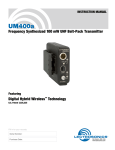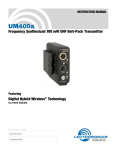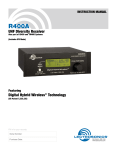Download Quick Start Guide - Lectrosonics.com
Transcript
Quick Start Guide Standard Belt-Pack Transmitters UM400a UM450 LMa U.S. Patent 7,225,135 Fill in for your records: Serial Number: This guide is intended to assist with initial setup and operation of your Lectrosonics product. Purchase Date: For a detailed user manual, download the most current version at: www.lectrosonics.com/manuals 06 jun10 Controls and Functions UM400a, UM450 transmitters LMa transmitter Input Jack Input Jack Power LED AUDIO LEVEL Control Power ON/OFF Switch Modulation LEDs AUDIO LEVEL Control Power LED Modulation LEDs Power ON/OFF Switch Antenna Jack Antenna CIRCULATOR/ISOLATOR 1.6M 100K Frequency Select Switches E D C B A F 0 1 9 8 7 2 6 3 4 5 Sliding Door E D C B A F 0 1 9 8 7 2 6 3 4 5 1.6M 100K Frequency Select Switches E D C B A F 0 1 9 8 7 2 6 3 4 5 E D C B A F 0 1 9 8 7 2 6 3 4 5 Low Frequency Roll Off Control 2 LECTROSONICS, INC. Audio Input Jack Accommodates most lavaliere and dynamic microphones, and line level signals. Power ON/OFF Switch Turns the transmitter on and off. Power LED Indicates power status and battery strength. Audio Level Control The front panel AUDIO LEVEL Control is used to adjust the incoming audio input level for proper modulation. Modulation LEDs The two bicolor Modulation LEDs provide a visual indication of the input audio signal level from the microphone. Frequency Select Switches Two 16-position rotary switches adjust the center frequency of the carrier. The 1.6M is a coarse adjustment and the 100K is the fine adjustment. UM400a, UM450: LMa: Antenna Antenna The flexible galvanized steel cable antenna supplied with the transmitter is removable via an SMA connector. Replacement antennas are available. Belt Clip The belt clip may be removed for special applications by removing one hex screw, accessible through the hole in the belt clip. The flexible galvanized steel cable antenna is permanently attached to the transmitter Belt Clip The wire belt clip may be removed for special applications by spreading the wire away from the housing and sliding it out of the holes. WARNING: Use ONLY the screw that is supplied. Adjustable Low Frequency Roll-Off The 18dB per octave low frequency roll-off control is used to remove subsonic (or very low frequency) audio, often produced by air conditioning systems, automobile traffic and other sources. www.lectrosonics.com 3 Operating Instructions Selecting the Compatibility Mode The UM400a, UM450, and LMa can be used with Lectrosonics 400 Series Digital Hybrid, 200 Series analog, 100 Series analog and some non-Lectrosonics analog wireless receivers. Contact the factory for details on the non-Lectrosonics models that can be used. The transmitter must be set to the operating mode of the matching receiver, which is done using the supplied screwdriver and a battery. The UM400a and UM450 are functionally identical, while the LMa lacks the manual low-frequency rolloff control. The LMa has an output of 50mW, the UM400a has 100mW output, and the UM450 has 250mW output. NOTE: The unit is supplied from the factory in the Hybrid mode. 1) Ensure the battery is good. 2) Turn off the transmitter. 3) With a small screwdriver (included), set the Frequency Select Switches to CC. (for Change, Change). 4) Power up the unit briefly – just long enough for the LED’s to light up and then turn it off - about one second. 5) Change the Frequency Select Switches to one of the following settings: • To set Lectrosonics 100 Series mode:1,1 • To set Lectrosonics 200 Series mode:2,2 • To set Mode 3*: 3,3 • To set Lectrosonics Hybrid mode: 4,4 • To set IFB mode: 5,5 • To set Mode 6*: 6,6 * contact the factory for details 6) Turn the unit on, wait about one second and turn off again. 7) Change the Frequency Select Switches to 0,0. 8) Turn on the transmitter to complete the operation. The LEDS will blink to indicate the selected compatibility mode. Immediately after power up, all LEDS will blink together red, then green, followed by the audio level LEDs (-20 and -10) blinking to indicate the mode. The -20 and -10 LEDs will blink: • Once for 100 Series mode • Two times for 200 Series mode • Three times for Mode 3 • Four times for 400 mode • Five times for IFB mode • Six times for Mode 6 At powerup the transmitter will confirm the current compatibility mode with the number of blinks listed here. This setting will remain the same until you reset it with the procedure listed above. 4 LECTROSONICS, INC. Attaching a Microphone and Adjusting Gain 1) Ensure the battery is in good condition. 2) Insert the microphone plug into the input jack, aligning the pins; be sure that the connector locks. 3) Attach the antenna to the SMA connector on the top of the transmitter. 4) Mute the associated receiver’s audio output. 5) Turn on the transmitter. 6) Position the microphone in the location you will use in actual operation. While speaking or singing at the same voice level that will actually be used, observe the Modulation LEDs. Adjust the AUDIO LEVEL control until the –20 dB LED Signal Level -20 LED -10 LED glows green with occasional red flickers and Off Off Less than -20 dB -10 dB glows green. Green Off -20 dB to -10 dB This will set the gain Green Green of your transmitter so -10 dB to +0 dB peaks are between +0 Red Green dB and +10 dB modula+0 dB to +10 dB tion. Red Red Greater than +10 dB 7) Once the gain has been adjusted, the mixer or recorder can be turned on to make level adjustments. NOTE: The transmitter Audio Level Control should not be used to control the volume of your sound system or recorder levels. This gain adjustment matches the transmitter gain with the user’s voice level and microphone positioning. Operating Notes If the audio level is too high — both LEDs will blink red frequently or glow a steady red. This condition may reduce the dynamic range of the audio signal. If the audio level is too low — neither LED will glow, or only the -20 LED will glow green. This condition may cause hiss and noise in the audio. Different voices will usually require different settings of the AUDIO LEVEL control, so check this adjustment as each new person uses the system. If several different people will be using the transmitter and there is no time to make the adjustment for each individual, adjust it for the loudest voice. www.lectrosonics.com 5 Frequency Select Switches Two 16-position rotary switches adjust the center frequency of the carrier. The 1.6M is a coarse adjustment and the 100K is the fine adjustment. Changing the Frequency E D C B A F 0 1 9 8 7 1.6M 2 6 3 4 5 E D C B A F 0 1 9 8 7 2 6 3 4 5 100K Locate the two small rotary switches. (On the UM400a/UM450, slide open the small door on the side of the transmitter.) With the small screwdriver supplied with the kit, turn the left switch to the first character in the two-digit Transmitter Frequency Switch Setting code, then turn the right switch to the second character of the two-digit code. For example: the frequency display is 623.000, F 0 1 F 0 1 2 2 E E Frequency 3 D and 3two-digit D Transmitter C C 4 4 Switch Setting the lefthand switch 5 is 56, thus 5 B code B F 0 1 F 0 1 6 6 A A 2 2 E E 9 8 7 8 7 on your transmitter should be9 set to “5” and the 3 3 D D C C 4 4 righthand switch to “6”. 5 5 B B A 9 8 7 6 A 9 8 7 6 5 6 Transmitter Frequency Select Switches Note: Be sure to orient the transmitter so the nomenclature reads correctly (not upside down). If you are using a receiver with a frequency scan function, find a clear frequency with the receiver, then set the transmitter to match. With Lectrosonics 400 Series receivers, a front panel LCD character display will indicate the correct transmitter switch settings as a two-character alphanumeric hex code once a clear frequency has been located with the scan function. 6 LECTROSONICS, INC. Battery Installation UM400a/UM450 To open the battery compartment, press outward on the cover door in the direction of the arrow as shown in the illustration. Only firm, sliding pressure is needed to open and close the battery door. Swing the door open and take note of the polarity marked inside showing the location of the positive (+) and negative (-) terminals. You can also see the large and small contact holes inside the battery compartment with the door open. Insert the battery correctly and close the cover by pressing the door closed and across, reversing the opening procedure. If the battery is inserted incorrectly, the door will not close. Do not force the door closed. LMa To replace the battery, push up on the Battery Compartment Door and rotate it clockwise. Remove the old battery and take note of the polarity marked inside showing the location of the positive (+) and negative (-) terminals. (You can see the large and small contact holes inside the battery compartment with the door open.) Insert the new battery correctly and close the Battery Compartment Door by reversing the opening procedure. If the battery is inserted incorrectly, the door will not fully close. Do not force the door closed. The Power LED glows green when the battery is good and the transmitter is turned on. The LED will glow yellow/orange as the battery voltage drops and finally glows red when there are about 30 minutes of operation left (when using an alkaline battery). The LED then blinks red when there are only a few minutes of life left. NOTE: While a LiPolymer battery provides long operating time, it will give little or no warning when depleted. If you use a LiPolymer battery in the UM450, we recommend trying a fully charged battery in the unit, noting the length of time that the battery will run the unit and in the future use somewhat less than that time to determine when the battery needs to be replaced. A weak battery will sometimes light the Power LED to the “good” green indication immediately after being put in the unit, but will quickly discharge to the point where the LED will go red or shut down (just like a flashlight with “dead” batteries). If the lamp fails to light, the battery should be replaced. www.lectrosonics.com 7




















